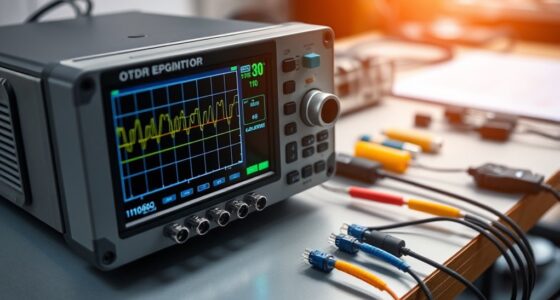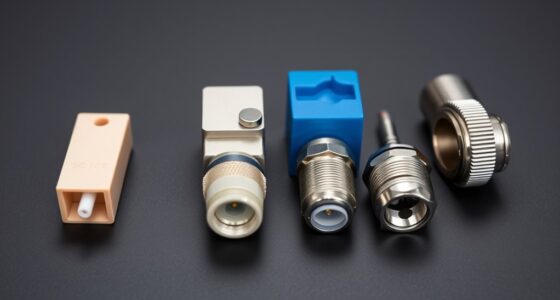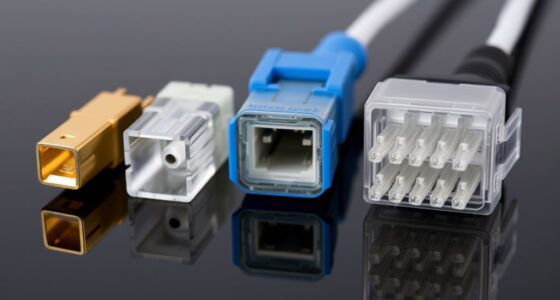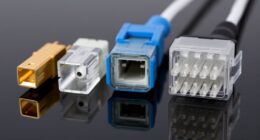Understanding SFP, SFP+, and QSFP modules helps you choose the right transceivers for your network needs. SFP modules are compact and support basic fiber or copper connections, while SFP+ offers higher speeds up to 10 Gbps. QSFP modules provide even greater capacity, often supporting up to 100 Gbps for data centers and enterprise networks. Exploring these options deepens your knowledge of transceiver features, compatibility, and deployment scenarios—you’ll discover how each fits into your network environment.
Key Takeaways
- SFP, SFP+, and QSFP are compact optical transceiver modules that enable high-speed data transmission over fiber optic or Ethernet cables.
- SFP modules support speeds up to 1 Gbps, SFP+ up to 10 Gbps, and QSFP modules can handle 40 Gbps or higher.
- These modules are interchangeable within their standards but require compatibility with network equipment and fiber types.
- They are used in data centers, enterprise networks, and telecom for scalable, high-speed connectivity over various distances.
- Proper selection depends on fiber type, required speed, and distance, ensuring optimal network performance and compatibility.
Overview of Optical Transceiver Modules

Optical transceiver modules are vital components in modern communication networks, enabling the transmission and reception of data over fiber optic cables. When selecting a module, understanding fiber types is critical, as different fibers—single-mode or multimode—require specific transceivers. Single-mode fibers, used for long-distance links, typically operate at wavelengths around 1310 or 1550 nanometers, so your transceiver’s wavelength selection must match. Multimode fibers, suited for shorter distances, usually operate at 850 or 1300 nanometers. Proper wavelength selection guarantees maximum performance and minimal signal loss. The compatibility between fiber types and transceiver wavelengths determines data transmission quality, making it necessary to match these parameters carefully when choosing optical transceiver modules for your network.
Key Features of SFP Modules

SFP modules are designed with a compact form factor, making them easy to install in tight spaces and reducing overall equipment size. They also offer versatile connectivity options, supporting various fiber and copper interfaces to meet different network needs. These features make SFP modules a flexible and efficient choice for modern networking setups. Additionally, understanding industry standards aids in selecting compatible modules for optimal performance. The use of high-quality components in manufacturing ensures durability and reliable data transmission over longer distances. Furthermore, selecting modules that adhere to industry standards helps ensure interoperability across different devices and systems. Proper adherence to industry standards can also simplify maintenance and future upgrades by ensuring consistent compatibility.
Compact Design Benefits
Thanks to their compact design, SFP modules offer significant advantages for network installations where space is limited. Their small footprint enhances space efficiency, making them ideal for crowded data centers and tight server racks. This design allows you to maximize your equipment without sacrificing performance. The lightweight nature simplifies installation and maintenance. The compact form factor also enables easier upgrades and scalability, as you can add more modules in confined spaces. Overall, the space efficiency of SFP modules helps you optimize your network infrastructure, reducing clutter and improving airflow. Their port density allows for more flexible network configurations, supporting growing data demands. Additionally, the thermal management benefits of compact modules contribute to maintaining optimal operating conditions in densely packed environments. Proper heat dissipation is essential to ensure reliable performance and longevity of the modules in high-density setups. Furthermore, the size advantage of these modules facilitates deployment in diverse environments, including remote or space-constrained locations.
Versatile Connectivity Options
The compact design of SFP modules not only saves space but also provides a wide range of connectivity options to suit diverse network needs. You can choose from various fiber optic or copper interfaces, enabling seamless integration with different equipment. This versatility ensures you can support multiple data rates and distances. Key features include:
- Compatibility with fiber optic cables for long-distance, high-speed transmissions, maintaining signal integrity.
- Support for copper connections for short-range, cost-effective solutions.
- Flexibility to upgrade or replace modules without replacing entire systems, ensuring future-proof connectivity.
- Understanding of potential security vulnerabilities in network modules helps in maintaining secure connections.
This adaptability allows you to optimize network performance, whether for data centers, enterprise networks, or telecommunications. SFP modules deliver reliable, versatile connectivity tailored to your specific requirements.
Enhancements and Capabilities of SFP+ Modules

Building upon the basic functions of standard SFP modules, SFP+ modules offer significant enhancements that boost network performance and flexibility. They support higher data rates, typically up to 10 Gbps, making them ideal for demanding fiber optic connections. These modules incorporate advanced signal amplification techniques, which help maintain data integrity over longer distances. The improved design reduces latency and increases throughput, ensuring smoother data transmission. SFP+ modules are backward compatible with SFP ports, giving you more versatility in your network setup. Their enhanced capabilities allow for quicker data transfer, making them suitable for data centers and high-speed enterprise networks. Additionally, the ability to maximize space and organization in network infrastructure can be achieved more effectively with modular components like SFP+ modules. The interoperability of SFP+ modules with various network equipment further simplifies deployment and maintenance. With their advanced technology, SFP+ modules can support emerging network standards and future upgrades. Overall, SFP+ modules provide a robust upgrade, combining fiber optic technology with advanced signal amplification to deliver faster, more reliable connections. Compatibility with existing infrastructure is a key factor in their widespread adoption.
The Role and Advantages of QSFP Modules

QSFP modules excel at high-speed data transfer, making them ideal for demanding network applications. Their compact design saves space and simplifies installation, especially in data centers. Plus, their versatile connectivity options allow you to seamlessly support different network configurations. Additionally, the availability of various performance kits enables users to customize and optimize their network hardware for specific needs. Understanding the market demand for high-performance networking components helps in selecting the appropriate QSFP modules for your infrastructure. The growing trend toward fiber optic technology further emphasizes the importance of choosing modules that can handle increasing bandwidth requirements. As technology advances, component compatibility becomes crucial to ensure seamless integration within existing network systems.
High-Speed Data Transfer
As data demands continue to grow exponentially, high-speed data transfer becomes essential for maintaining efficient network performance. QSFP modules excel in this area by offering superior data throughput, making them ideal for high-performance applications. Their advantages include:
- Enhanced Fiber Optic Support: QSFP modules support advanced fiber optic cables, enabling longer distances and reliable connections. Incorporating fiber optic technology ensures that networks remain resilient and capable of handling the increasing volume of data transmitted over long distances.
- Increased Data Rates: They provide data transfer speeds up to 100 Gbps, markedly reducing bottlenecks.
- Scalability & Flexibility: Multiple channels allow for future expansion without replacing existing infrastructure.
- The use of high-speed modules allows networks to keep pace with the rapid evolution of data transmission needs. These features ensure your network can handle massive data flows efficiently, keeping up with evolving demands. With QSFP modules, high-speed data transfer isn’t just faster; it’s more reliable, scalable, and capable of supporting your growing fiber optic and data throughput needs.
Compact Design Benefits
Thanks to their compact design, QSFP modules save valuable space in your networking equipment, making them ideal for environments where rack space is limited. Their space efficiency allows you to maximize your existing infrastructure without sacrificing performance or connectivity options. The compact form factor also simplifies installation and maintenance, reducing clutter and making cable management easier. This design enables organizations to deploy higher port densities in smaller footprints, which is especially beneficial for data centers and enterprise networks. By choosing QSFP modules with a compact design, you optimize your equipment’s physical layout while ensuring reliable, high-speed connections. Overall, the space-saving nature of QSFP modules enhances efficiency, reduces costs, and supports scalable network growth.
Versatile Connectivity Options
The compact design of QSFP modules not only saves space but also enables a wide range of connectivity options to meet diverse network needs. With QSFP, you can:
- Support high-speed fiber optic data transmission over multiple channels simultaneously, boosting bandwidth.
- Connect different network architectures, including 40GbE and 100GbE, for flexible data center deployments.
- Use various transceiver types, such as active optical cables (AOCs) and direct attach copper (DAC), for cost-effective solutions.
- The versatility of QSFP modules is further enhanced by their ability to support multi-rate configurations, allowing seamless adaptation to changing network requirements. Additionally, their compatibility with various network standards ensures broad applicability across different systems.
- Implementing standardized transceivers ensures consistent quality and interoperability within diverse network setups. This standardization also helps reduce equipment incompatibility issues across different vendors.
These features make QSFP modules highly versatile, allowing you to tailor connectivity based on your network’s performance and distance requirements. Whether upgrading existing infrastructure or deploying new systems, QSFP’s adaptability ensures seamless, high-capacity data transmission across diverse fiber optic applications.
Compatibility and Interchangeability Considerations
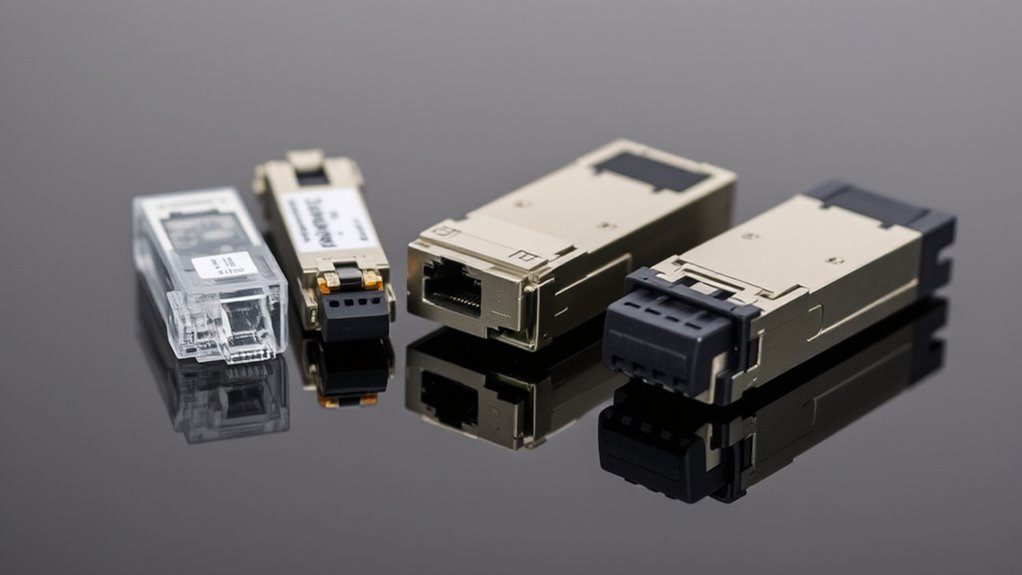
When selecting SFP, SFP+, or QSFP modules, compatibility and interchangeability are crucial considerations to guarantee seamless network operation. You need to understand that not all modules follow the same standards, which can create compatibility challenges. Interchangeable standards are limited, meaning a module designed for one type may not work with another, even if the ports look similar. Always verify the module’s specifications with your equipment’s requirements. Some vendors may advertise compatibility, but differences in signal types, data rates, or form factors can cause issues. To avoid disruptions, check whether your device supports the specific standards and protocols of the module. Ensuring compatibility upfront prevents costly mistakes and network downtime.
Typical Use Cases and Deployment Scenarios

SFP, SFP+, and QSFP modules are chosen based on specific deployment scenarios to meet network performance and distance requirements. In enterprise networking and data center deployments, selecting the right module is vital. Consider these common use cases:
- Connecting servers and switches within data centers for high-speed data transfer.
- Extending network links across campus or building distances with fiber optics.
- Enabling link aggregation for increased bandwidth and redundancy.
These modules support a variety of applications, from short-distance connections in data centers to long-haul links in enterprise networks. Your choice depends on factors like speed, distance, and port density. Proper deployment guarantees reliable connectivity, optimized performance, and scalability for growing network demands.
Differences in Speed, Distance, and Power Consumption
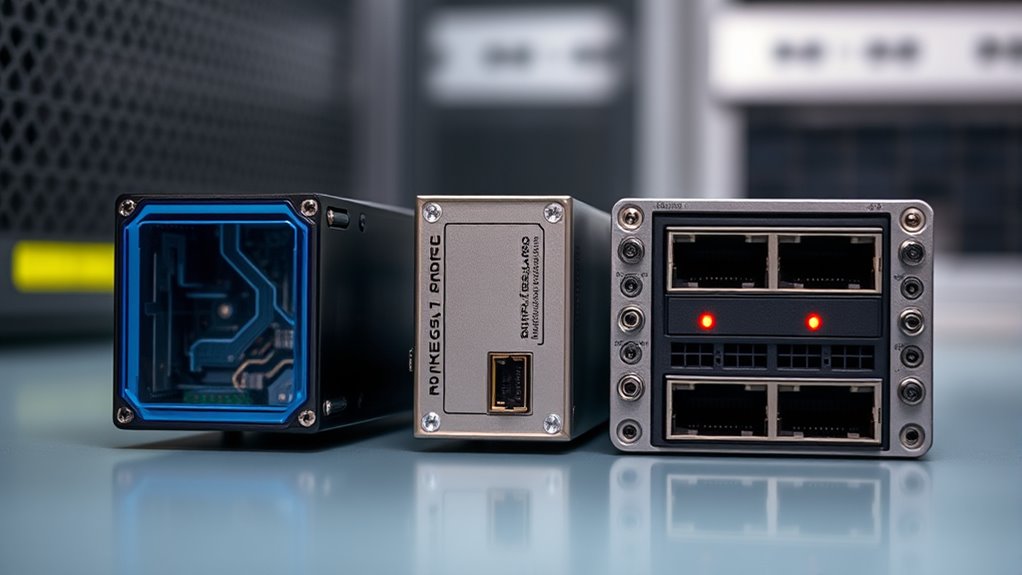
Understanding the differences in speed, distance, and power consumption among SFP, SFP+, and QSFP modules is essential for selecting the right solution for your network needs. SFP modules typically support data rates up to 1 Gbps and are suitable for shorter fiber optic runs, often up to 100 meters, with moderate power use. SFP+ modules increase speed to 10 Gbps, offering longer reach with effective signal amplification, which helps maintain signal quality over greater distances. QSFP modules deliver even higher bandwidth, up to 100 Gbps, but may require more power and advanced fiber optic infrastructure. Longer distances often depend on fiber optic quality and the need for signal amplification, which boosts signal strength without sacrificing speed or increasing power consumption excessively.
Future Trends and Developments in Transceiver Technology

Advancements in transceiver technology are rapidly shaping the future of high-speed networking. You can expect significant progress in areas like quantum networking, which promises ultra-secure data transfer, and photonic integration, enabling smaller, more efficient modules. Here are three key trends to watch:
Advancements in transceiver tech will boost speed, security, and miniaturization in high-speed networks.
- Quantum Networking: Transceivers will incorporate quantum encryption, enhancing security for sensitive data.
- Photonic Integration: Combining photonics and electronics on a single chip will reduce size, power, and cost.
- Higher Data Rates: Developments will push data transfer speeds beyond current limits, supporting the growth of data-intensive applications.
These innovations will make transceivers faster, more secure, and more compact, shaping the future of high-speed connectivity.
Frequently Asked Questions
What Are the Main Differences Between SFP, SFP+, and QSFP Modules?
You’ll notice that SFP, SFP+, and QSFP modules differ mainly in their speed, compatibility, and port types. SFP modules support up to 1Gbps, while SFP+ offers higher speeds up to 10Gbps. QSFP modules handle even more data, up to 100Gbps. Your choice depends on your device’s compatibility and the signal quality you need for reliable data transfer, with QSFP being ideal for high-density, high-speed setups.
How Do Transceiver Modules Impact Network Scalability and Performance?
Transceiver modules directly impact your network’s scalability and performance by enabling higher speeds and longer fiber optic connections. They help sustain signal integrity over extended distances, reducing data loss and latency. As your network grows, choosing the right modules ensures smooth data transmission, prevents bottlenecks, and supports future upgrades. This flexibility allows you to expand your infrastructure efficiently while maximizing fiber optic capabilities and preserving high-quality network performance.
Are There Compatibility Issues Between Different Brands of Transceiver Modules?
Yes, compatibility issues can arise between different brands of transceiver modules. You might face challenges with brand compatibility and vendor interoperability, which can affect network performance. To avoid these issues, it’s best to choose modules that are specifically designed for your equipment or certified for interoperability. Always check the specifications and compatibility lists provided by the manufacturer to ensure seamless integration and peak network operation.
What Are the Common Troubleshooting Steps for Optical Transceiver Failures?
Imagine your network as a delicate web of glowing fibers, ready to shimmer but sometimes falter. When facing optical transceiver failures, you should start fiber optic troubleshooting by inspecting connections, cleaning connectors, and verifying compatibility. Next, run transceiver failure diagnostics using diagnostic LEDs and software tools. Replace any suspect modules and check for firmware updates. These steps help you quickly pinpoint issues and restore your network’s luminous flow.
How Do Environmental Factors Affect the Performance of Transceiver Modules?
Environmental factors like temperature fluctuations and humidity effects can substantially impact your transceiver modules’ performance. When temperatures vary too much, the modules may overheat or freeze, leading to signal degradation or failure. High humidity can cause condensation, resulting in corrosion or short circuits. To maintain peak performance, keep the environment controlled—avoid extreme temperatures and high humidity—to guarantee your transceivers operate reliably and extend their lifespan.
Conclusion
Understanding SFP, SFP+, and QSFP modules is like choosing the right tool for a job—they each have unique strengths. By knowing their differences in speed, distance, and capabilities, you can select the perfect transceiver for your network needs. Staying updated on future trends is key, so you’re always prepared. Think of these modules as the backbone of your network, ensuring smooth data flow like a well-oiled machine.

